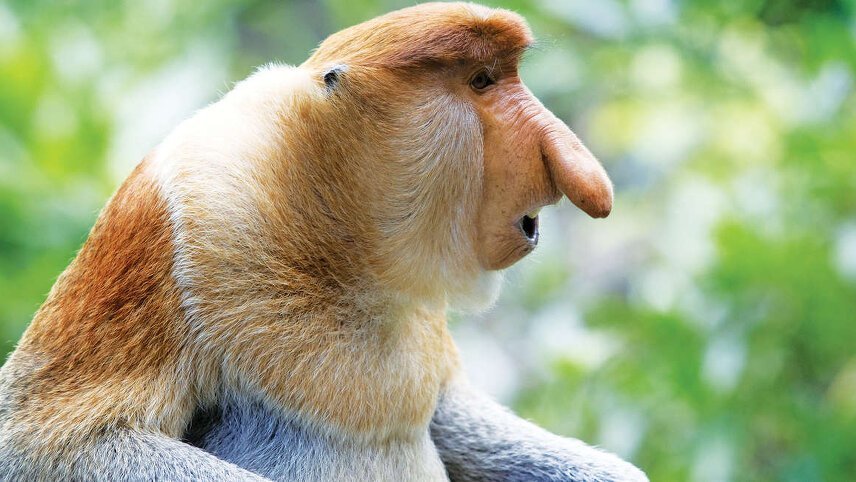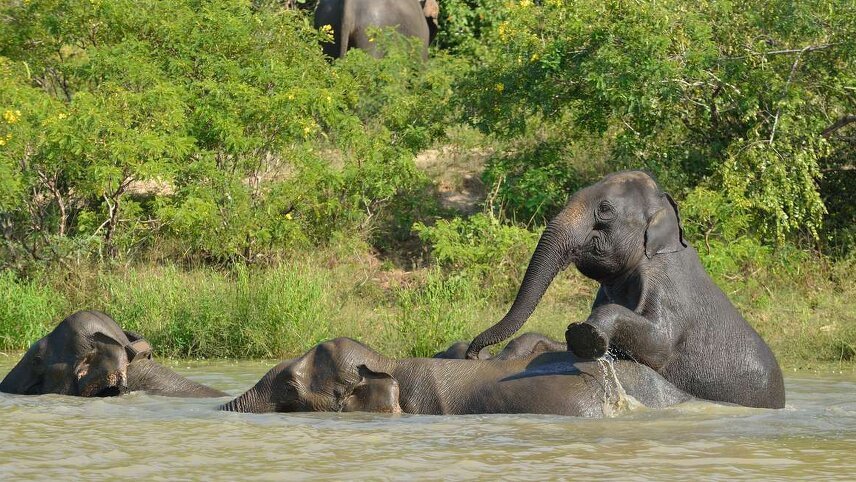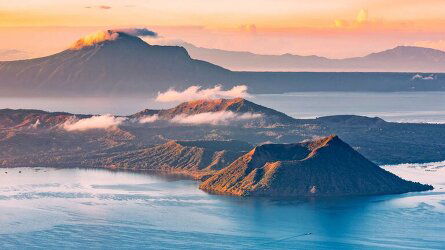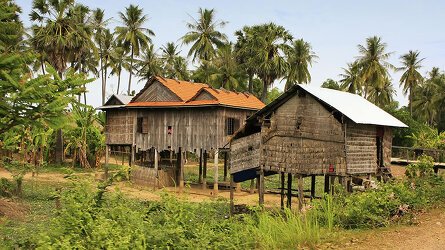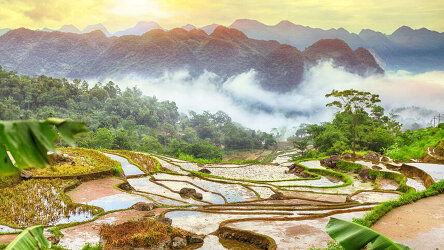Overview
Itinerary
For those arriving on time our Leader plans to meet you in the hotel reception at 6pm for the welcome meeting. There are no other activities planned today, so you are free to arrive in Kuching at any time. If you would like an airport transfer today, you'll need to arrive into Kuching International Airport (KCH), which is 20 minutes from the hotel. Should you miss the welcome meeting, your Leader will inform you of any essential information over breakfast on day 2.
If your flight arrives earlier in the day, perhaps you might choose to visit the waterfront for a bite to eat and a visit to the fruit market. Stay: Meritin Hotel (Comfortable)
The history of modern Sarawak began when the English adventurer James Brooke sailed up the Sarawak River in his schooner in 1839. Today we discover Kuching, a veritable treasure trove of historical buildings and remarkable stories concentrated around the south bank of the waterfront. We start our walk exploring India Street, flanked by century colourful shop houses. Following a narrow passageway, we discover a hidden small Indian Mosque. We continue on to the Old Kuching Courthouse, the first Brooke era administrative building and The Pavillion, originally used as a medical headquarters. Our city tour takes us to the Main Bazaar, one of the oldest streets and observe the antiques and handicrafts outlets found here and the 175-year-old temple, Tua Pek Kong Temple, a singular Chinese temple and its dominant dragon.
We the retrace this historic route with a Sampan (traditional boat) ride down the very same river which still bustles with its charm and enjoy some local snacks during the cruise. Across the river we benefit form a 360 panoramic view of Kuching and the historical landmarks, all set against a background of picturesque Malay Villages and distant mountains. Stay: Meritin Hotel (Comfortable) (B)
First thing in the morning, we depart Kuching for a 45-minute drive to Bako Fishing Village. We continue by motorized boat for a 30-minute cruise along the beautiful coast to reach Bako National Park.
The oldest of Sarawak's national parks, Bako offers the perfect introduction to Sarawak's forests and wildlife. It is also home to 275 rare proboscis monkeys, found only in Borneo. We have the chance to observe the fabulous proboscis monkeys, silvered langurs, bearded pigs and monitor lizards. Despite its seemingly small size, Bako contains a wide range of vegetation - swamp forest, scrub-like padang vegetation, mangrove forest, dipterocarp forest, delicate cliff vegetation and beautiful sandy beaches.
We explore further the rainforest on a variety of walking trails going past mighty 80-metre dipterocarps to dense mangrove forest. For bird enthusiasts, Bako is the home to many species such as the rufous-backed kingfisher, stork-billed kingfisher, red-crowned barbet, white-bellied woodpecker and many more. During low tide, observe the mudskippers and blue-fiddler crabs coming out from their hideout for feeding on the beaches.
After a simple lunch at the park café we return to Bako Village by boat and transfer onward transfer to Kuching. Stay: Meritin Hotel (Comfortable) (B/L)
We transfer to the airport for our onwards flight to Mulu, our home for the next two nights. Depending on the arrival time, there are a variety of free options which include a wander to the Tree Top Tower for views across the roof of the Mulu National Park, a stroll along the boardwalk to Pukau Waterfall or a stroll on the Nature Heritage Trail.
In the afternoon we depart for Mulu National Park Headquarters and go on an elevated plank-walk to Lang Cave, the longest cave passage in the world (2,161m) which adjoins Deer Cave. We explore Lang Cave with its magnificent stalactites and stalagmites before proceeding to Deer Cave, where the biggest attraction is a colony of thousands of free-tailed bats. At dusk, we witness an amazing spectacle of nature as thousands of these bats emerge from the cave in formation to forage for insects in the rainforest.
On our way back, we experience night trekking through the jungle. The way is dotted with luminescent fungi and blinking fireflies, a fabulous opportunity to view creatures not visible in daylight. Stay: Mulu Park HQ (Simple) (B/D)
After breakfast, which is accompanied by the sound of the jungle's morning chorus, we take a 15-minute longboat ride up the Melanau River to experience two more of Mulu's \ must-see\ limestone caves: Wind Cave and Clearwater Cave. These form part of the Sarawak Chamber - the largest connected cave system in the world. If water levels are low, we will have the chance to reach the caves on foot along a beautiful short trail. We explore the „ King's Room„ before proceeding to Clearwater Cave by walking on plank walkways that were built on the sides of limestone cliffs leading to the cave. We then climb up steep steps that were carved into the side of the hill to get to the entrance of Clearwater Cave. Inside the cave, we admire the details of its various features and limestone formations.
We return to Mulu National Park Headquarters by boat and we take to the treetops on a canopy walkway. The rest of the afternoon is at leisure or you may choose to head out on some of the self-guided walking trails in Mulu National park. Stay: Mulu Park HQ (Simple) (B/L)
This morning we head to the airport and take a short flight to Kota Kinabalu; KK as it is affectionately known by the locals. The small capital is a cultural melting pot and its inhabitants are a mix of Chinese, Indonesian, Filipino, Indian and of course Malay. This blend of influences makes KK a foodie's dream, with fusion restaurants popping up all over town and street-food stalls serving up classics like Nasi Goreng (fried rice with spices) and satay alongside curries and kimchi. We will land at lunch time and the rest of the day has been left free to explore the city's vibrant foodie scene. Stay: Hotel Shangri-La (Comfortable) (B)
We set off this morning to explore the sights of KK. Having been bombed extensively during World War II, KK's architecture is awash with modernity, occasionally interspersed with the remaining historical buildings, mosques and ramshackle markets. We first visit Tun Musthapha tower, the tallest building in the city that encapsulates the city's new and modern feel. Next we get a feel for the cultural diversity of the city when visiting the beautiful Chinese temple of Puh Toh Tze followed by the impressive State Mosque. This much-photographed mosque features intricate examples of Islamic architecture with gold motifs decorating its grand dome. We end at Signal Hill, where the observation platform offers great views over the city skyline.
This afternoon has been left free to relax or to further explore the city, perhaps visiting the handicraft market. Alternatively there is an optional trip to the nearby Mari Mari village, a traditional settlement that celebrates and preserves the indigenous tribes of Borneo. Stay: Hotel Shangri-La (Comfortable) (B)
After a leisurely breakfast we leave the city limits and after approximately two and a half hours reach the Crocker Mountain Range, home to the highest mountain in South East Asia - Mount Kinabalu (4095m). We will travel to the small village of Tanak Nabalu where we share lunch with the local villagers. The people here are from the ethnic Dusan tribe, most of which now offer their services as guides and porters up to Mount Kinabalu's summit. We spend time with them learning about their ancient cultures and customs over a hearty lunch of Hinava. Similar to the Peruvian dish ceviche, Hinava is a raw fish dish which originates from Sabah's Kadazan Dusun tribes. Mackerel is the traditional fish used in Sabah, and this is marinated in lime and served with red chilli, ginger, shallots, Bambangan seeds, and prawns.
After lunch we enjoy a gentle stroll through the Botanical Gardens taking in some exotic species of flora such as slipper orchids, a variety of pitcher plants, yellow rhododendron and much more. En route we stop at the World War Two Memorial Park, which commemorates the thousands of Allied forces, including British and Australian, that lost their lives at the hands of the Japanese empire. We then make the short drive onto the town of Kundasang, our rest stop for the night. Stay: Perkasa Hotel (Comfortable) (B/L)
This morning we travel east and visit the Poring Hot Springs, an incredible collection of natural geothermal pools dotted throughout the forest. Here we can take a dip in the natural mineral-rich waters and spot monkeys and birds on the canopy walk that traverses the springs. There will also be an option to visit an Orchid Conservation Centre.
We then move on to a Rafflesia farm. Known as the 'corpse flower' due to its strong smell, it is possible the largest existing flower. From here we drive onto Sepilok, approximately a four hour drive where we plan to arrive in the late afternoon. Stay: Sepilok Jungle Resort (Simple) (B)
This morning we set off on foot to the Sun Bear Conservation Centre. Sun bears are the smallest bears and their survival has been threatened by decades of ongoing deforestation. In the wild, they play a key role in ensuring the health of the forest. Here, orphaned or confiscated sun bears are cared for and rehabilitated, with the ultimate goal to return them back into their natural habitat.
We then carry on walking to the Sepilok Orang-utan Sanctuary. A highlight for many of Borneo's visitors, Sepilok is home to the largest of the three orang-utan rehabilitation centres in the world. Covering over 4,000 hectares of forest, the centre was established in 1964 to rehabilitate captured, injured or abandoned apes. So far about 100 'wild men of the forest' have been brought to the centre, and there has been a remarkable success rate with up to 75% having returned to the jungle. The animals are taught how to make nests and how to survive in their natural habitat. We plan to visit the centre in time for feeding when, along with the resident apes, females who normally live in the jungle, come to supplement their diet after the birth of their young.
After lunch we will drive to Sukau, located along Sabah's longest river, the Kinabatangan. After some rest time we will set off for our first river cruise, hoping to spot some of the endemic wildlife dotted among Sukau's myriad waterways.
For those feeling energetic, tonight we will go on a night walk in the jungle for a chance to spot nocturnal animals like the civet cat, tarsier, slow lloris as well as owls, frogs and a variety of insects. Stay: Bilit Rainforest Lodge (Comfortable) (B/L/D)
Waking to the distant calls of gibbons and hornbills, we rise for breakfast before joining a morning river cruise to Kelenanap Oxbow Lake. The Kinabatangan River area plays host to an incredible array of wildlife - a total of 10 primate species including proboscis monkeys, langur monkeys, gibbons and macaques are all common sightings here; with a bit of luck we might also get a sighting of an orang-utan in the wild! The area is also known for pygmy elephants, Malay sun bears, clouded leopards, crocodiles and the Sumatran rhino. Birdlife is just as prolific, with all eight species of hornbill present, not to mention kingfishers, ospreys, storks and eagles.
We embark on another river cruise this afternoon where we hope to be able to spot some more of this varied wildlife from our boat with the help of our expert guide.
After dinner this evening there will be the chance to go back out for an optional night cruise - an excellent opportunity to see the water lit up by fluorescent light, hoping to see the shine of a pair of eyes staring back at us. Stay: Bilit Rainforest Lodge (Comfortable) (B/L/D)
We head deeper into the rainforest today on our three and a half hour drive to the Reserve of Tabin. On the route this morning we see many reminders of man's interference with nature. Much of the route to the conservation area has been de-forested and replaced with vast swathes of palm oil plantations. Malaysian Borneo and Indonesia account for over 90% of the world's production of palm oil, and the drive today gives first-hand experience of the problem it causes by displacing endemic and endangered wildlife and flora. The guide will add some extra insight into the palm-oil industry, a complex issue that isn't pleasant to witness, but is very much a reality in modern-day Borneo. Fortunately the Tabin Wildlife Reserve has long been kept as a conservation area, meaning the rainforest here has remained entirely intact.
The Tabin Wildlife Reserve was created in 1984 to preserve some of Sabah's most endangered species, and covering an area of some 122,000 hectares it the largest in Malaysia. Tabin is home to the Sunda Clouded Leopard and the Borneo Elephant, as well as seven of Sabah's primates and a huge array of bird species.
In the afternoon we head out for our first walk, along the Elephant trail to the Lipad Mud Volcano. This small active volcano provides a mineral salt lick and thus attracts a multitude of wildlife which we hope to spot. A variety of animal footprints are usually visible across the mud, and the adventurous can try out the effects of the mud which is said to be excellent for skin care.
Our accommodation for the next two nights is the Tabin Wildlife Resort, a charming collection of wooden chalets built on stilts that look out over the river and surrounding hills. The chalets are comfortably appointed with en-suite facilities and a ceiling fan, and the resort also has a restaurant and bar. Stay: Tabin Wildlife Resort (Comfortable) (B/L/D)
We rise early this morning amongst the birdsong and gibbon calls to travel to the core of the reserve, climbing the observation tower to discover some of Tabin's near 300 species of birds. Here we hope to spot species such as the Bronzed Drongo, Blue-crowned Hanging Parrot and Purple-throated Sunbird, to name but a few. We then move onto Orang-utan Release Centre and learn about the important work the centre plays in the final step of releasing rehabilitated Orang-utans back into wild. From here we continue on foot, through the lush steamy rainforest to Lipad Waterfall, where it's possible to take a dip in the natural pools and brave a refreshing shower under the falls.
The afternoon has been left free to relax in the natural surroundings, or perhaps try out the Tabin Rainforest Foot Soak - a mixture comprised from a natural blend of locals herbs to ease those weary feet.
After dinner there will be the option to head out on a night walk, to keep an ear and eye out for some of the nocturnal wildlife found nearby the resort. Stay: Tabin Wildlife Resort (Comfortable) (B/L/D)
There is a final chance for another nature walk this morning before we leave our accommodation behind at lunch time and drive to the bustling town of Sandakan. Stay: Sabah Hotel (Comfortable) (B)
The trip ends after breakfast at our hotel in Sandakan.
There are no activities planned today, so you are free to depart from Sandakan u at any time. If your flight is departing later in the day luggage storage facilities are available at our hotel. If you would like an airport transfer today, you need to depart from Sandakan Airport (SDK), which is 20 minutes from the hotel. (B)
For those arriving on time our Leader plans to meet you in the hotel reception at 6pm for the welcome meeting. There are no other activities planned today, so you are free to arrive in Kuching at any time. If you would like an airport transfer today, you'll need to arrive into Kuching International Airport (KCH), which is 20 minutes from the hotel. Should you miss the welcome meeting, your Leader will inform you of any essential information over breakfast on day 2.
If your flight arrives earlier in the day, perhaps you might choose to visit the waterfront for a bite to eat and a visit to the fruit market. Stay: Meritin Hotel (Comfortable)
The history of modern Sarawak began when the English adventurer James Brooke sailed up the Sarawak River in his schooner in 1839. Today we discover Kuching, a veritable treasure trove of historical buildings and remarkable stories concentrated around the south bank of the waterfront. We start our walk exploring India Street, flanked by century colourful shop houses. Following a narrow passageway, we discover a hidden small Indian Mosque. We continue on to the Old Kuching Courthouse, the first Brooke era administrative building and The Pavillion, originally used as a medical headquarters. Our city tour takes us to the Main Bazaar, one of the oldest streets and observe the antiques and handicrafts outlets found here and the 175-year-old temple, Tua Pek Kong Temple, a singular Chinese temple and its dominant dragon.
We the retrace this historic route with a Sampan (traditional boat) ride down the very same river which still bustles with its charm and enjoy some local snacks during the cruise. Across the river we benefit form a 360 panoramic view of Kuching and the historical landmarks, all set against a background of picturesque Malay Villages and distant mountains. Stay: Meritin Hotel (Comfortable) (B)
First thing in the morning, we depart Kuching for a 45-minute drive to Bako Fishing Village. We continue by motorized boat for a 30-minute cruise along the beautiful coast to reach Bako National Park.
The oldest of Sarawak's national parks, Bako offers the perfect introduction to Sarawak's forests and wildlife. It is also home to 275 rare proboscis monkeys, found only in Borneo. We have the chance to observe the fabulous proboscis monkeys, silvered langurs, bearded pigs and monitor lizards. Despite its seemingly small size, Bako contains a wide range of vegetation - swamp forest, scrub-like padang vegetation, mangrove forest, dipterocarp forest, delicate cliff vegetation and beautiful sandy beaches.
We explore further the rainforest on a variety of walking trails going past mighty 80-metre dipterocarps to dense mangrove forest. For bird enthusiasts, Bako is the home to many species such as the rufous-backed kingfisher, stork-billed kingfisher, red-crowned barbet, white-bellied woodpecker and many more. During low tide, observe the mudskippers and blue-fiddler crabs coming out from their hideout for feeding on the beaches.
After a simple lunch at the park café we return to Bako Village by boat and transfer onward transfer to Kuching. Stay: Meritin Hotel (Comfortable) (B/L)
We transfer to the airport for our onwards flight to Mulu, our home for the next two nights. Depending on the arrival time, there are a variety of free options which include a wander to the Tree Top Tower for views across the roof of the Mulu National Park, a stroll along the boardwalk to Pukau Waterfall or a stroll on the Nature Heritage Trail.
In the afternoon we depart for Mulu National Park Headquarters and go on an elevated plank-walk to Lang Cave, the longest cave passage in the world (2,161m) which adjoins Deer Cave. We explore Lang Cave with its magnificent stalactites and stalagmites before proceeding to Deer Cave, where the biggest attraction is a colony of thousands of free-tailed bats. At dusk, we witness an amazing spectacle of nature as thousands of these bats emerge from the cave in formation to forage for insects in the rainforest.
On our way back, we experience night trekking through the jungle. The way is dotted with luminescent fungi and blinking fireflies, a fabulous opportunity to view creatures not visible in daylight. Stay: Mulu Park HQ (Simple) (B/D)
After breakfast, which is accompanied by the sound of the jungle's morning chorus, we take a 15-minute longboat ride up the Melanau River to experience two more of Mulu's \ must-see\ limestone caves: Wind Cave and Clearwater Cave. These form part of the Sarawak Chamber - the largest connected cave system in the world. If water levels are low, we will have the chance to reach the caves on foot along a beautiful short trail. We explore the „ King's Room„ before proceeding to Clearwater Cave by walking on plank walkways that were built on the sides of limestone cliffs leading to the cave. We then climb up steep steps that were carved into the side of the hill to get to the entrance of Clearwater Cave. Inside the cave, we admire the details of its various features and limestone formations.
We return to Mulu National Park Headquarters by boat and we take to the treetops on a canopy walkway. The rest of the afternoon is at leisure or you may choose to head out on some of the self-guided walking trails in Mulu National park. Stay: Mulu Park HQ (Simple) (B/L)
This morning we head to the airport and take a short flight to Kota Kinabalu; KK as it is affectionately known by the locals. The small capital is a cultural melting pot and its inhabitants are a mix of Chinese, Indonesian, Filipino, Indian and of course Malay. This blend of influences makes KK a foodie's dream, with fusion restaurants popping up all over town and street-food stalls serving up classics like Nasi Goreng (fried rice with spices) and satay alongside curries and kimchi. We will land at lunch time and the rest of the day has been left free to explore the city's vibrant foodie scene. Stay: Hotel Shangri-La (Comfortable) (B)
We set off this morning to explore the sights of KK. Having been bombed extensively during World War II, KK's architecture is awash with modernity, occasionally interspersed with the remaining historical buildings, mosques and ramshackle markets. We first visit Tun Musthapha tower, the tallest building in the city that encapsulates the city's new and modern feel. Next we get a feel for the cultural diversity of the city when visiting the beautiful Chinese temple of Puh Toh Tze followed by the impressive State Mosque. This much-photographed mosque features intricate examples of Islamic architecture with gold motifs decorating its grand dome. We end at Signal Hill, where the observation platform offers great views over the city skyline.
This afternoon has been left free to relax or to further explore the city, perhaps visiting the handicraft market. Alternatively there is an optional trip to the nearby Mari Mari village, a traditional settlement that celebrates and preserves the indigenous tribes of Borneo. Stay: Hotel Shangri-La (Comfortable) (B)
After a leisurely breakfast we leave the city limits and after approximately two and a half hours reach the Crocker Mountain Range, home to the highest mountain in South East Asia - Mount Kinabalu (4095m). We will travel to the small village of Tanak Nabalu where we share lunch with the local villagers. The people here are from the ethnic Dusan tribe, most of which now offer their services as guides and porters up to Mount Kinabalu's summit. We spend time with them learning about their ancient cultures and customs over a hearty lunch of Hinava. Similar to the Peruvian dish ceviche, Hinava is a raw fish dish which originates from Sabah's Kadazan Dusun tribes. Mackerel is the traditional fish used in Sabah, and this is marinated in lime and served with red chilli, ginger, shallots, Bambangan seeds, and prawns.
After lunch we enjoy a gentle stroll through the Botanical Gardens taking in some exotic species of flora such as slipper orchids, a variety of pitcher plants, yellow rhododendron and much more. En route we stop at the World War Two Memorial Park, which commemorates the thousands of Allied forces, including British and Australian, that lost their lives at the hands of the Japanese empire. We then make the short drive onto the town of Kundasang, our rest stop for the night. Stay: Perkasa Hotel (Comfortable) (B/L)
This morning we travel east and visit the Poring Hot Springs, an incredible collection of natural geothermal pools dotted throughout the forest. Here we can take a dip in the natural mineral-rich waters and spot monkeys and birds on the canopy walk that traverses the springs. There will also be an option to visit an Orchid Conservation Centre.
We then move on to a Rafflesia farm. Known as the 'corpse flower' due to its strong smell, it is possible the largest existing flower. From here we drive onto Sepilok, approximately a four hour drive where we plan to arrive in the late afternoon. Stay: Sepilok Jungle Resort (Simple) (B)
This morning we set off on foot to the Sun Bear Conservation Centre. Sun bears are the smallest bears and their survival has been threatened by decades of ongoing deforestation. In the wild, they play a key role in ensuring the health of the forest. Here, orphaned or confiscated sun bears are cared for and rehabilitated, with the ultimate goal to return them back into their natural habitat.
We then carry on walking to the Sepilok Orang-utan Sanctuary. A highlight for many of Borneo's visitors, Sepilok is home to the largest of the three orang-utan rehabilitation centres in the world. Covering over 4,000 hectares of forest, the centre was established in 1964 to rehabilitate captured, injured or abandoned apes. So far about 100 'wild men of the forest' have been brought to the centre, and there has been a remarkable success rate with up to 75% having returned to the jungle. The animals are taught how to make nests and how to survive in their natural habitat. We plan to visit the centre in time for feeding when, along with the resident apes, females who normally live in the jungle, come to supplement their diet after the birth of their young.
After lunch we will drive to Sukau, located along Sabah's longest river, the Kinabatangan. After some rest time we will set off for our first river cruise, hoping to spot some of the endemic wildlife dotted among Sukau's myriad waterways.
For those feeling energetic, tonight we will go on a night walk in the jungle for a chance to spot nocturnal animals like the civet cat, tarsier, slow lloris as well as owls, frogs and a variety of insects. Stay: Bilit Rainforest Lodge (Comfortable) (B/L/D)
Waking to the distant calls of gibbons and hornbills, we rise for breakfast before joining a morning river cruise to Kelenanap Oxbow Lake. The Kinabatangan River area plays host to an incredible array of wildlife - a total of 10 primate species including proboscis monkeys, langur monkeys, gibbons and macaques are all common sightings here; with a bit of luck we might also get a sighting of an orang-utan in the wild! The area is also known for pygmy elephants, Malay sun bears, clouded leopards, crocodiles and the Sumatran rhino. Birdlife is just as prolific, with all eight species of hornbill present, not to mention kingfishers, ospreys, storks and eagles.
We embark on another river cruise this afternoon where we hope to be able to spot some more of this varied wildlife from our boat with the help of our expert guide.
After dinner this evening there will be the chance to go back out for an optional night cruise - an excellent opportunity to see the water lit up by fluorescent light, hoping to see the shine of a pair of eyes staring back at us. Stay: Bilit Rainforest Lodge (Comfortable) (B/L/D)
We head deeper into the rainforest today on our three and a half hour drive to the Reserve of Tabin. On the route this morning we see many reminders of man's interference with nature. Much of the route to the conservation area has been de-forested and replaced with vast swathes of palm oil plantations. Malaysian Borneo and Indonesia account for over 90% of the world's production of palm oil, and the drive today gives first-hand experience of the problem it causes by displacing endemic and endangered wildlife and flora. The guide will add some extra insight into the palm-oil industry, a complex issue that isn't pleasant to witness, but is very much a reality in modern-day Borneo. Fortunately the Tabin Wildlife Reserve has long been kept as a conservation area, meaning the rainforest here has remained entirely intact.
The Tabin Wildlife Reserve was created in 1984 to preserve some of Sabah's most endangered species, and covering an area of some 122,000 hectares it the largest in Malaysia. Tabin is home to the Sunda Clouded Leopard and the Borneo Elephant, as well as seven of Sabah's primates and a huge array of bird species.
In the afternoon we head out for our first walk, along the Elephant trail to the Lipad Mud Volcano. This small active volcano provides a mineral salt lick and thus attracts a multitude of wildlife which we hope to spot. A variety of animal footprints are usually visible across the mud, and the adventurous can try out the effects of the mud which is said to be excellent for skin care.
Our accommodation for the next two nights is the Tabin Wildlife Resort, a charming collection of wooden chalets built on stilts that look out over the river and surrounding hills. The chalets are comfortably appointed with en-suite facilities and a ceiling fan, and the resort also has a restaurant and bar. Stay: Tabin Wildlife Resort (Comfortable) (B/L/D)
We rise early this morning amongst the birdsong and gibbon calls to travel to the core of the reserve, climbing the observation tower to discover some of Tabin's near 300 species of birds. Here we hope to spot species such as the Bronzed Drongo, Blue-crowned Hanging Parrot and Purple-throated Sunbird, to name but a few. We then move onto Orang-utan Release Centre and learn about the important work the centre plays in the final step of releasing rehabilitated Orang-utans back into wild. From here we continue on foot, through the lush steamy rainforest to Lipad Waterfall, where it's possible to take a dip in the natural pools and brave a refreshing shower under the falls.
The afternoon has been left free to relax in the natural surroundings, or perhaps try out the Tabin Rainforest Foot Soak - a mixture comprised from a natural blend of locals herbs to ease those weary feet.
After dinner there will be the option to head out on a night walk, to keep an ear and eye out for some of the nocturnal wildlife found nearby the resort. Stay: Tabin Wildlife Resort (Comfortable) (B/L/D)
There is a final chance for another nature walk this morning before we leave our accommodation behind at lunch time and drive to the bustling town of Sandakan. Stay: Sabah Hotel (Comfortable) (B)
The trip ends after breakfast at our hotel in Sandakan.
There are no activities planned today, so you are free to depart from Sandakan u at any time. If your flight is departing later in the day luggage storage facilities are available at our hotel. If you would like an airport transfer today, you need to depart from Sandakan Airport (SDK), which is 20 minutes from the hotel. (B)
Trip Inclusions
- A two week wildlife full immersion in Borneo's jungles of Sabah and Sarawak
- Cruise along Bako's rainforest and marvel at Mulu National park's pinnacles
- Visit Sepilok Orang-utan Sanctuary and spend three nights in a lush wildlife reserve
- Visit the famous Sepilok Orang-utan Sanctuary and witness the excellent rehabilitation work
- Cruise through the Kinabatangan River spotting proboscis monkeys and hornbills
- Trek to a mud volcano and search for clouded leopard, pygmy elephant and gibbons in the Tabin Wildlife Reserve
- Moderate pace tours are ideal if you want a holiday which combines exciting activities and experiences with plenty of time to relax and unwind. Typically you'll be active and busy for part of the day but then also have time to rest and recharge your batteries.
- Accommodation, itinerary and inclusions subject to change.
- Price is for land, cruise and internal flights as specified. Flights not specified are not included
- A two week wildlife full immersion in Borneo's jungles of Sabah and Sarawak
- Cruise along Bako's rainforest and marvel at Mulu National park's pinnacles
- Visit Sepilok Orang-utan Sanctuary and spend three nights in a lush wildlife reserve
- Moderate pace tours are ideal if you want a holiday which combines exciting activities and experiences with plenty of time to relax and unwind. Typically you'll be active and busy for part of the day but then also have time to rest and recharge your batteries.
- Accommodation, itinerary and inclusions subject to change.
- Price is for land, cruise and internal flights as specified. Flights not specified are not included
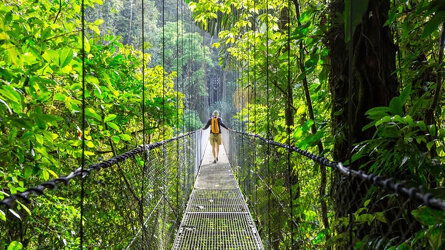
Launching in 1981, Explore offer trips from over 130 countries - from classic small group tours. Read more
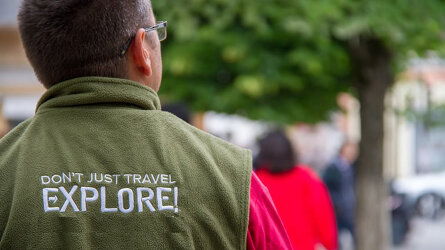
Explore's leaders are more than just your typical guide. They're your local expert are are passionate about sharing their expertise with you. Read more
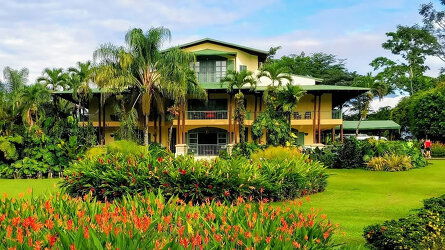
The places Explore stay are every bit as important as the sights they visit and the things you do. Read more

Launching in 1981, Explore offer trips from over 130 countries - from classic small group tours. Read more

Explore's leaders are more than just your typical guide. They're your local expert are are passionate about sharing their expertise with you. Read more

The places Explore stay are every bit as important as the sights they visit and the things you do. Read more
Brochure
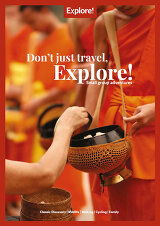
Explore Small Group Adventures (2024-25)
Availability
A definite departure means minimum numbers have been reached for this departure to operate. Your Global Journeys Travel Advisor will check the availability of your departure date when you enquire. Additional savings may apply. We guarantee the lowest price in Australia. T&C’s apply.
Tour & cruises prices are per person. Prices shown have savings applied, are subject to availability and may be withdrawn at any time without notice. Pricing and trip details are correct at this point in time, however are subject to confirmation at the time of booking and are subject to change by Explore. For cruise itineraries, cabin images are sourced from Explore. These should be treated as indicative only. Cabin inclusions, upholsteries and room layout may differ to the image(s) shown depending on the ship selected and your sailing dates.
